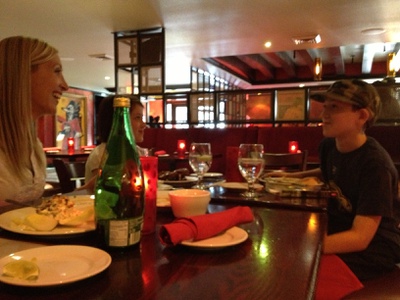Saturday, June 14, 2014 | 2 a.m.
Related story
The horde of patrons who got sick from salmonella at Firefly Tapas Kitchen & Bar last year has long since recovered. Most who filed negligence claims and lawsuits against the popular Las Vegas eatery have reached settlements by now, too.
Yet more than a year after the outbreak, a legal cloud lingers over the restaurant's owners as they strive to restore the brand's reputation as a local favorite. Unresolved claims remain against the restaurant, and potential plaintiffs have plenty of time to seek damages before Nevada's two-year statute of limitations runs its course.
"It's not uncommon for these things to drag on," said UNLV law professor Ruben Garcia. "It's not uncommon for there to be, in such a large class, some people who want a different deal. People had varying injuries and varying reactions."
Lawsuits spawned by the outbreak accuse restaurant owner John Simmons of negligence after customers fell ill from salmonella poisoning and rushed to doctor’s offices and hospitals with high fever, heartburn, diarrhea and muscle cramps.
Two such patrons are Minnesotans Katie Yokiel and Jonathan Radford, who had just been married in Las Vegas and were celebrating the start of their honeymoon when they ate at Firefly.
"They were utterly distraught," said their Texas-based attorney, Tony Coveny. "First Katie got sick, then Jonathan. They wanted to change their flight, but they just didn't have any money. They were in all kinds of problems."
The Settlements
Yokiel and Radford are among more than 300 patrons who have since settled their claims with Firefly. A Minneapolis-based mediating agency helped the restaurant come up with offers from the restaurant's insurance provider. Firefly had liability insurance to cover the settlements, but the policy topped out at total payments of $3 million. The sum of the damages sought by plaintiffs was in excess of $3 million, attorneys said.
By the numbers
Demographics of patrons and employees affected by the salmonella outbreak at Firefly:
• Median age was 33 years* (range was 2 to 87)
• 154 (46 percent) were male
• 181 (54 percent) were female
• 202 (60 percent) were Nevada residents
• 128 (38 percent) were from out of state
• 5 (2 percent) were from out of the country
*Age not known for 9 patrons
SOURCE: Southern Nevada Health District
Attorneys representing plaintiffs who settled declined to say how much money clients received, citing a nondisclosure agreement, though they expressed general satisfaction with the outcome of the cases.
Mediators came up with a wide range of settlements for patrons, depending on the severity of their symptoms, said Las Vegas attorney Jason Weiner. His client, Nick Candela, initially sought $10,000 for hospital bills and emotional distress in the aftermath of falling sick from a visit to Firefly.
"They did kind of a breakdown depending on whether (a plaintiff) went to the hospital or just stayed at home," Weiner said. "(Amounts sought) were way above their insurance (policy), so they figured out how much everybody's claims had to be reduced across the board."
The restaurant's lawyers have not responded to requests for information about the claims, instead referring questions to Firefly's insurance provider, Farmers Insurance.
Farmers spokesman Luis Sahagun said at least 300 plaintiffs had settled as of early June, but he declined to give a specific number. He noted that "a few people" still have cases pending against the restaurant.
New plaintiffs likely won't emerge because by now there probably isn't much more money left that the restaurant could offer, said UNLV law professor Thomas Main, who specializes in civil procedure.
"There's an incentive for people to come forward earlier in that process rather than later so they can be a part of whatever the earlier distribution is when there seems to be at least some insurance proceeds to fund some sort of recovery for these people," Main said. "But, could people crawl out of the woodwork until the statute of limitations expires? Absolutely. They could even crawl out after the statute of limitations expires, because there are some exceptions even to that."
Salmonella poisoning doesn't generally affect people longer than a year, so anyone who became seriously sick likely already has recovered and filed a claim with the restaurant if they needed financial relief, Main said.
The Outbreak
At least 330 people from 29 states and five foreigners were affected by the outbreak in April and May 2013 at the restaurant, prompting a months-long investigation by the Southern Nevada Health District that ultimately could not pinpoint the source of the bacteria. The probe, finalized in January, traced salmonella bacteria to a chorizo sample, though experts believe it may have been contaminated within the kitchen.
Factoid
Salmonella bacteria live in the intestinal tracts of infected humans and animals, and can be transmitted to others through the ingestion of the organisms in food and/or drink contaminated by the feces of those infected. Salmonella outbreaks often involve beef, dairy, fish and poultry. Salmonella bacteria can grow and spread when food is not kept at adequate temperatures and when cross-contamination occurs during food handling. SOURCE: Southern Nevada Health District
The outbreak, which led local headlines for months, was one of the biggest cases of food poisoning in the city's history. The previous salmonella outbreak at a local restaurant was Thanksgiving weekend 1997, when 40 people said they ate at Binion's Coffee Shop and got sick. Doctors diagnosed 27 of them with a strain of salmonellosis.
Each year, about 40,000 cases of salmonellosis are reported in the United States, according to the federal Centers for Disease Control and Prevention. Because milder cases aren't usually reported, the actual number of infections could be at least 30 times greater. Infections are more common in the summer than winter.
"You need a really good, whopping dose of salmonella to cause illness," said Linh Nguyen, an epidemiologist with the Southern Nevada Health District who led the investigation into the Firefly case. "With this many people being sick, one figures whatever salmonella they had was at a really good temperature for growth. Refrigeration was poor, there wasn't any disinfectant in their wet cloths. A lot of things just came together (to encourage bacteria growth)."
That restaurant has since been shut down at the request of health officials, though Simmons opened a new Firefly location down the street on Paradise Road. Its Sahara Avenue location, which was open before the outbreak at the original location, remained unaffected. In April, Simmons said he shut down a third spot in Henderson because business was slow and he wanted to shift his attention to a new business endeavor, a Mexican restaurant called Tacos and Beer.
Simmons opened Tacos and Beer with other local restaurateurs at the original Firefly location on Paradise. The plan had been in the works before the Firefly outbreak.
Firefly's Recovery
Though some legal hurdles remain, most of the affected patrons have been compensated, which means Simmons can focus less on litigation and more on restaurant operations.
At its worst point, Simmons told the Las Vegas Weekly, business at all Firefly restaurants was down 80 percent, and the company had to lay off 20 percent of its staff.
Since the outbreak, Firefly revamped its kitchen operations, hired a dedicated food-safety expert and signed up staffers for food-handling classes. It also bought new refrigeration equipment, including a device that alerts managers via text message if food temperatures become unsafe.
"One of the things that we recognized was we needed to make some changes," said Simmons' wife, Tabitha Simmons. "We wanted to become industry leaders in sanitation."
Those efforts are key in restoring a business' reputation, said Kurt Ouchida, a managing partner who specializes in crisis control at local public relations firm BrainTrust Marketing Communications.
Ouchida noted the restaurant slowly seemed to be rebuilding its popularity among Las Vegas diners, though "there is still damage."
Both Firefly locations have Yelp ratings of 4 stars out of 5. The original location, which had more than five times as many reviews as its replacement on Paradise Road, had a rating of 4.5.
Routine inspections by the Southern Nevada Health District at both Firefly locations in April yielded "A" ratings for each restaurant.
"(Simmons) may never win back certain fans," Ouchida said. "But he took responsibility immediately and established credibility, which I think was applauded by the general public."
Recovery efforts have been physically and emotionally tolling on the Simmonses and their restaurant's staff, Tabitha Simmons said.
"But the good news is, people have been so good to us," she said. "We worked really hard to keep people's trust and regain it. We have taken (the outbreak) so seriously."



Join the Discussion:
Check this out for a full explanation of our conversion to the LiveFyre commenting system and instructions on how to sign up for an account.
Full comments policy